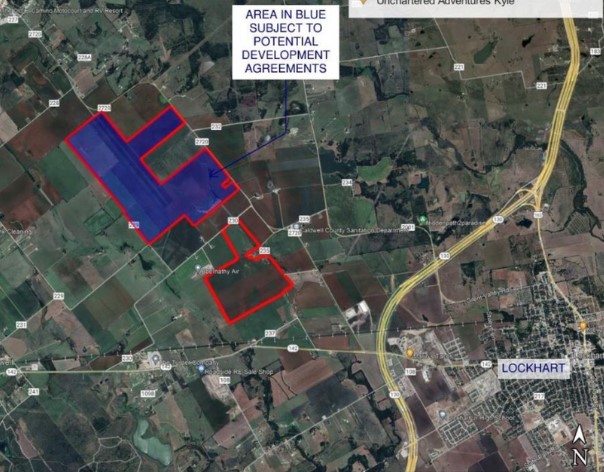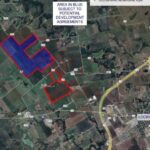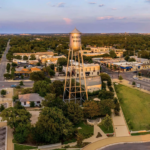Plan would far outstrip current data center capacity in Austin-San Antonio market
Executives from Denver-based Tract said its 1,515-acre data center campus at the Caldwell County megasite could support 800 jobs and 4 gigawatts of data center space at full buildout — roughly the equivalent of 20 times the current data center capacity of the entire Austin and San Antonio market.
The company on May 7 confirmed the acquisition of several tracts along Farm to Market Road 2720 near Uhland, about 30 miles south of Austin, just a day after the deal was reported by the Austin Business Journal. The ABJ first linked the company to the site about six months ago.
Tract, which builds master-planned data center campuses, said the acquisition from Arizona-based Walton Global Holdings LLC comes after 18 months of working with myriad state agencies, local communities and utility providers. The company said it has an agreement with power company Bluebonnet Electric Cooperative to bring an initial 360 megawatts online in 2028 and also has provisions for on-site supplemental power generation.
Chief Investment Officer Graham Williams said the company is still finalizing some aspects of the plan but intends to build the project over the next decade. He described plans for 2 gigawatts of data center space as conservative, saying the company would be able to support multistory data center spaces and around 4 gigawatts of data center space if it can “find the right energy mix on-site.”
That total would dwarf the current inventory of 191 megawatts in the Austin-San Antonio data center market, according to February data from CBRE. Another 463.5 megawatts currently are under construction, 97% of which is pre-leased. For reference, there are 1,000 megawatts per gigawatt.
Williams also said other estimates for the site are conservative. An estimate of the capital investment hasn’t been released, but Tract pegs the horizontal infrastructure alone at between $50 million and $100 million. Tract expects to create 800 jobs at full buildout, but the site will require thousands of employees over the next decade, including construction workers and skilled trade workers like electricians. At least 5.5 million square feet of building space is planned — roughly the scope of 50 H-E-B grocery stores.
Tract markets its projects to data center developers and users, including hyperscale cloud companies like Microsoft Corp. and Meta Platforms Inc., the parent company of Facebook, or to wholesale data center operators such as QTS Realty Trust LLC or Compass Datacenters, which can lease data storage to multiple companies in a facility.
Williams said the company became interested in the megasite primarily because of its mix of high-tension electricity transmission lines, natural gas lines, fiber connectivity, on-site power generation and access to water. He said the plan is to use newer technologies like closed-loop systems to minimize water use.
“There aren’t very many locations where at 1,500 acres-plus, you have all of those elements come together,” he said.
Micron Technology Inc. looked at the site in 2022 for a multibillion-dollar semiconductor factory before choosing a location in New York.
The property is split between Lockhart and Uhland’s extraterritorial jurisdictions and is across the street from a $4 billion data center campus project by Dallas-based Prime Data Centers LLC. Walton Global Holdings previously earmarked the property to be part of the Caldwell Valley mixed-use district.
Tract amended the 2017 development agreement over the last six months. In February, the Uhland City Council gave the go-ahead to approve the changes. Around that time, the Lockhart City Council voted to terminate its agreement with Walton. Williams said the project is fully entitled and supports both industrial and data center uses.
“I know (stakeholders in the area) were really excited to try to win Micron, and when that didn’t work, they were really effective at pivoting for another use that would value the same sort of infrastructure right up to the point of also including the ability to generate electricity on-site,” Williams said. “That is a big priority within Texas and ERCOT to minimize impacts on the grid and where we’re big believers that having that capability makes the site unique.”
He said the biggest challenge was working through the coordination of entitlements, infrastructure and utilities, due to the sheer size of the site.
“The only way to overcome those challenges is to have a longer-term plan so that we’re not making the same mistakes that some in our industry are making just running to figure what they can build in the next three years,” Williams said. “We’re really focused on a longer 10-year plan, and the way you overcome those scale challenges is by local engagement and persistence and knowing that these processes take time. If you try to rush them, you’ll run into unintended consequences, or you’ll disappoint your partners. So this is an investment of time and energy over years to get to where we are, and now is when the real work starts.”
Project celebrated
Tract CEO Grant van Rooyen, who also is managing partner of Tract Capital Management and executive chairman of Tract, lauded the state’s business-friendly environment for making the project attractive, as well as the municipal partners and workforce.
“This megasite in Caldwell County is unique for public cloud, inferencing and AI training applications because it sits at the intersection of transmission infrastructure, robust natural gas infrastructure and long-haul fiber,” he said in a statement. “Perhaps most importantly, there is a workforce in place that can support the thousands of skilled construction and operations jobs that will be employed at this campus.”
Uhland Mayor Lacee Duke previously told the ABJ the company has been a “wonderful partner,” adding that executives have been upfront and cooperative about their plans via weekly meetings — a move that is not common with developers. They also have not yet asked for any incentives from the city. That has quelled some trepidation from residents about such a big project headed to a small city.
“Change is nerve-wracking for any community. You’re reticent it will be as good as it appears,” she said. However, “it’s unavoidable and I think that with this partner they genuinely take the word partnership to heart.”
Caldwell County Judge Hoppy Haden said Tract hasn’t asked for incentives from the county either. The company was receptive to requests to help with an expansion of FM 2720 to support the development, which he said showed a willingness to partner with the community, which is among the fastest-growing counties in the country.
Mike Kamerlander, President and CEO of Hays Caldwell Economic Development Partnership, said in a statement: “Tract is an experienced data center site developer that does things the right way and has demonstrated that throughout the process with Caldwell County and Uhland. We look forward to supporting Tract’s efforts to make its site in Caldwell County the premier destination for data centers in Texas and beyond.”
Texas Gov. Greg Abbott also lauded the project’s job creation, as well as how it is expected to bolster the state’s power grid and enhance its technology infrastructure.
Growth tear
Tract has been on a growth tear. The company has now acquired more than 25,000 acres in more than 10 markets for more than 25 gigawatts of planned capacity after raising $1.7 billion from investors.
Tract recently pitched 447 acres near Minneapolis for a data center campus, and has revealed plans for a $20 billion campus on more than 2,000 acres near Phoenix that will accommodate 1.8 gigawatts of power with 40 facilities across 20 million square feet of space at full buildout. Other planned developments span 11,000 acres in Nevada, 668 acres in Utah and 1,200 acres in Virginia.
Data center campuses are proliferating throughout Austin’s outskirts. The Austin metro is among the fastest-growing data center markets in the country, according to August data from CBRE based on the first half of 2024. The ABJ has identified more than a dozen in various stages of completion, in cities ranging from Hutto to San Marcos to Georgetown to Temple, and in counties that include Caldwell, Bastrop, Hays and Williamson.
Data centers are massive hubs for computer processing power — commonly called “the cloud” — that are used by many companies and industries. While they don’t create many long-term jobs, they do add value to a city’s tax rolls because of the large amount of investment at the sites. But the U.S. data center boom has drawn criticism based on a variety of factors, such as the amount of power and water the facilities use.
———-
Originally written by Justin Sayers for the Austin Business Journal









